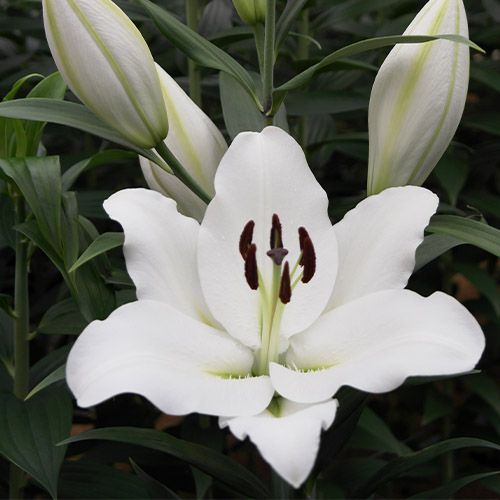
Goliath and Tree Lilies
Goliath and Tree Lilies
Last Reviews
The Ultimate Guide to Growing Tree Lilies: Tips and Tricks for Beautiful Blooms
If youre looking for a beautiful and exotic plant to add to your home or garden, tree lilies are an excellent choice. These majestic plants have a tall and imposing presence, reaching up to 8 feet in height and producing huge, fragrant blooms in a variety of colors.
The Advantages of Tree Lilies
- For a variety of reasons, tree lilies are a popular choice among gardeners and plant enthusiasts. Here are some of the primary advantages of growing these plants:
- They produce massive, show-stopping blooms up to 10 inches across. These flowers are available in a variety of colors, including pink, red, white, and yellow.
- They are easy to grow and care for, making them a great option for beginners.
- They are hardy and can survive in a range of conditions, including full sun or partial shade.
The Appearance of Tree Lilies
Tree lilies are well-known for their eye-catching appearance. These plants have tall, sturdy stems that can grow up to 8 feet tall. Large, trumpet-shaped blooms up to 10 inches across can be found at the top of these stems. The blooms are composed of layers of petals and are available in a variety of colors such as pink, red, white, and yellow.
Introduction to Tree Lilies: What You Need to Know Before You Buy
Tree lilies are hybrid lilies that grow taller and have larger blooms. They are often referred to as tree lilies because they can reach heights of up to 8 feet and have multiple stems that create a tree-like appearance. Here are some things to know before buying tree lilies:
Growing Conditions: Tree lilies prefer full sun to partial shade and well-drained soil. They also require regular watering, especially during hot and dry weather.
Bulb Size: Tree lily bulbs are typically larger than other lily bulbs, which means they may require more space in the garden. When planting, space the bulbs at least 12 inches apart.
Blooming Time: Tree lilies typically bloom in mid- to late summer, with some varieties blooming into early fall. When selecting varieties, consider their blooming time to ensure continuous blooms throughout the season.
Maintenance: Tree lilies may require staking to support their tall stems and prevent bending or breaking. Deadheading spent blooms can also promote continued blooming throughout the season.
Variety: There are many different varieties of tree lilies, each with its own unique characteristics such as color, bloom size, and fragrance. Consider the variety that best fits your garden and personal preferences.
Toxicity: While tree lilies are beautiful, its important to note that they can poison cats. If you have cats in your household, consider planting other types of non-toxic lilies.
Tree Lilies for Sale: Where to Buy and What to Look For
If youre interested in buying tree lilies, here are some tips on where to buy and what to look for:
1.Garden Centers and Nurseries: Many garden centers and nurseries carry tree lilies. These are an ideal place to purchase tree lilies because you can see the plants in person and ask questions of the staff. Its critical to select healthy-looking plants with no signs of disease or damage.
2.Online Retailers: Online retailers offer a wide variety of tree lilies to choose from. When purchasing online, read the product description carefully to ensure youre getting the right variety and size of bulb. Also, read reviews from other customers to get an idea of the quality of the bulbs and the service provided by the retailer.
3.Specialty Bulb Companies: Lilies, including tree lilies, are available from specialty bulb businesses. These enterprises can be an excellent source of unusual or difficult-to-find products. Before buying something from a specialty bulb company, read reviews and investigate the companys reputation.
4.Look for Firm Bulbs: When buying tree lily bulbs, look for firm bulbs free of mold or soft spots. The larger the bulb, the more likely it is to produce a healthy plant.
5.Check the Planting Season: Since tree lilies are typically planted in the fall, make sure you buy the bulbs in time to plant them before the first frost. If you miss the fall planting season, tree lily bulbs can be grown instead.
Understanding Tree Lily Bulbs: How to Choose and Store Them
Tree lily bulbs should be stored in a cool, dry place until you plant them. Make sure to choose bulbs that are appropriate for your growing zone and suited to your soil type and light conditions. When storing bulbs, keep them away from moisture and direct sunlight.
How to Plant and Transplant Tree Lilies: Step-by-Step Guide
Tree lilies are stunning flowers that add beauty and fragrance to any garden or landscape. Heres a step-by-step guide on how to plant and transplant tree lilies.
Planting Tree Lilies
Step 1: Choose a planting location - Tree lilies prefer well-drained soil and partial to full sun exposure. Choose a location in your garden that meets these requirements.
Step 2: Prepare the soil - Add organic matter, such as compost or well-rotted manure, to the soil to improve its fertility and drainage.
Step 3: Dig a hole - Dig a hole that is about twice as wide as the bulb and about 6-8 inches deep.
Step 4: Add fertilizer - Add slow-release fertilizer to the bottom of the hole according to package instructions.
Step 5: Plant the bulb - Place the bulb in the hole with the pointed end facing up. Cover the bulb with soil and firm it in place.
Step 6: Water thoroughly - Water the bulb deeply after planting to settle the soil and ensure effective root contact.
Step 7: Mulch - Add a layer of organic mulch, such as shredded leaves or bark, to the soil surface to retain moisture and suppress weeds.
Transplanting Tree Lilies
Step 1: Choose a transplant location - Choose an appropriate location with the same soil and sun exposure requirements as the original planting location.
Step 2: Dig up the bulb - Use a garden fork or shovel to carefully dig up the bulb, being careful not to damage roots.
Step 3: Prepare the original planting location - Follow the same steps as planting a new bulb to prepare the ground planting location.
Step 4: Plant the bulb - Place the bulb in the freshly made hole with the pointed end facing up. Cover the bulb with soil and firm it in place.
Step 5: Water thoroughly - Water the bulb deeply after transplanting to settle the soil and ensure proper root contact.
Step 6: Mulch - Add a layer of organic mulch, such as shredded leaves or bark, to the soil surface to retain moisture and suppress weeds.
Step 7: Monitor and maintain - Continue to water the bulb regularly and fertilize as needed. Monitor the plant for any signs of stress or disease and address any issues promptly.
Planting Tree Lilies: Best Practices for Soil, Sunlight, and Watering
Choose a location that gets direct sun or partial shade when planting tree lilies. Verify that the soil has proper drainage and organic matter. Dig a hole big enough to fit the bulb but not so deep that it is buried too deeply underground. Water the bulb quickly after planting, and keep it moist until the plant is established.
Transplanting Tree Lilies: Tips for Successful Relocation
If you need to transplant established tree lilies, do so in the fall after the foliage dies back. Dig up the bulbs carefully, taking care not to damage the roots. Choose a new location with similar soil and light conditions to the original planting site. Replant the bulbs at the same depth they were originally planted, and water thoroughly.
Growing Tree Lilies in Pots: Everything You Need to Know
Tree lilies, also known as Oriental lilies, can be grown in pots to add color and fragrance to your patio, balcony, or indoor space. Heres everything you need to know about growing tree lilies in pots:
- Choosing a Pot
Choose a pot that is at least 12-14 inches in diameter and 12-14 inches deep to accommodate the bulb and allow for adequate root growth. The pot should have drainage holes at the bottom to prevent water accumulation and root rot.
- Soil Mix
Tree lilies prefer well-drained soil rich in organic matter. Use a potting mix formulated for bulbs and add additional organic matter, such as compost or well-rotted manure, to improve fertility and drainage.
- Light and Temperature
Tree lilies prefer partial to full sun exposure and temperatures between 60-75 F. Place the pot in a location that receives at least 6-8 hours of sunlight per day, such as a south-facing window or a sunny patio.
- Watering and Fertilizing
Water the tree lily regularly, keeping the soil moist but not waterlogged. Allow the soil to dry slightly between waterings, as overwatering can cause root rot.
Fertilize the tree lily once a month with a liquid fertilizer high in phosphorus, such as a 10-30-20 formula, to promote flowering.
- Maintenance
Monitor the tree lily for any signs of stress or disease, such as yellowing leaves or wilting. Address any issues promptly to prevent further damage.
After the tree lily flowers, allow the foliage to die back naturally before cutting it back to soil level. Store the pot in a cool, dry place for the winter, and resume watering and fertilizing in the spring to encourage regrowth.
Choosing the Right Pot and Soil for Tree Lilies in Containers
Choose a pot with a minimum size of 12 inches and a depth of 18 inches. To avoid moisture from collecting in the soil, make sure the pot has good drainage. Use a potting mix that uses up well and is high in organic matter.
Watering, Fertilizing, and Maintaining Tree Lilies in Pots
Water your tree lilies in pots regularly, keeping the soil moist but not waterlogged. Fertilize your plants every 2-3 weeks during the growing season with a balanced fertilizer. You may also need to stake your plants to keep them from toppling over due to their height.
Pruning Tree Lilies: When and How to Trim Your Plants
Tree lilies dont require much pruning, but you may need to remove dead or damaged foliage as needed. Wait until the foliage dies back in the fall before trimming it back. You can also deadhead spent blooms to encourage more flowers.
Protecting Tree Lilies from Pests and Diseases
Aphids, the red lily leaf beetle, and botrytis are a few typical pests and diseases that tree lilies are vulnerable to. Check your plants for damage or pest infestation regularly to protect them. As soon as possible, remove any damaged leaves or blooms, and if necessary, treat the plant with the proper pesticide or fungicide.
Winterizing Tree Lilies: Preparing Your Plants for Cold Weather
Its crucial to safeguard your tree lilies against frost and freezing weather in colder locations. Trim the leaves down to approximately 3 inches above the soil level in the fall after they have died. Mulch should be spread over the soil to insulate the bulbs and prevent freezing.
Frequently asked questions about Spring Flowering Goliath and Tree Lilies
What are giant tree lily bulbs?
Giant tree lily bulbs are bulbs of lily plants, which are among the most impressive and magnificent ornamental plants. They produce large, showy inflorescences that are often referred to as "tree lilies".
Which varieties of Danish Giant Tree Lily bulbs do you offer?
In our online shop, we offer a selection of different giant tree lily bulbs, including Asiatic lilies, Oriental lilies and hybrid lines. Each variety has its own characteristics and flower colours.
When is the best time to plant the giant tree lily bulbs?
The best time to plant giant tree lily bulbs is in autumn, usually from September to November, so that they can flower in spring. This gives the bulbs enough time to establish themselves.
Do Dutch Giant Tree Lilies require special care?
Giant tree lilies are relatively easy to care for, but they prefer well-drained soil and sunlight or slightly shady locations. It is important to drain the soil well to avoid waterlogging.
Can the bulbs be ordered from you online?
Yes, giant tree lily bulbs can be conveniently ordered from our online shop and delivered to your home. We offer a large selection of varieties and sizes for your garden.





































